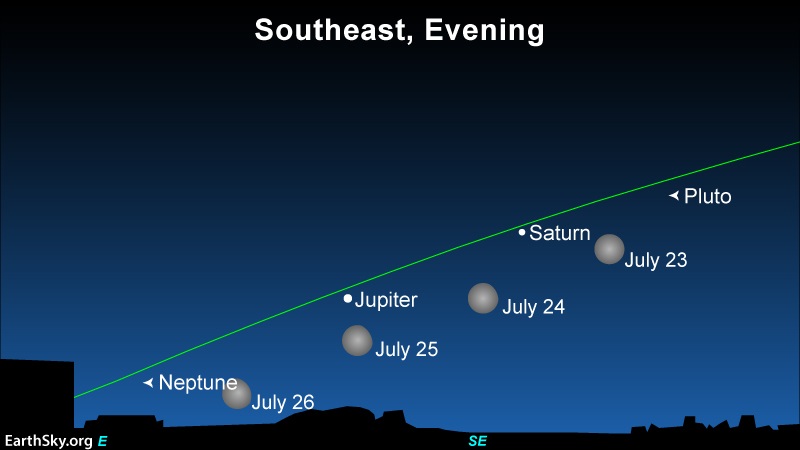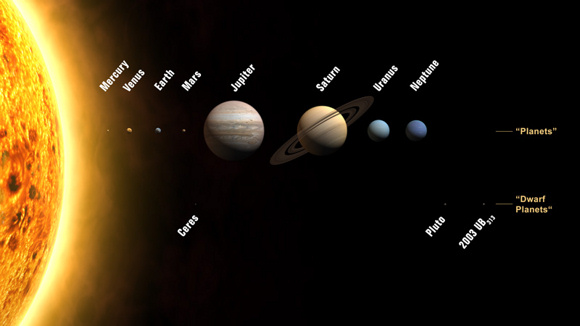
Full moon is July 23-24
We in North America call the July full moon the Buck Moon, Hay Moon or Thunder Moon. At this time of year, buck deer begin to grow velvety antlers. And farmers are loading hay in their barns, amid summer’s frequent thunderstorms. In 2021, the July full moon falls on the night of July 23-24. And on the nights of July 23 to 26, you can watch as this full or just-past-full moon sweeps past our solar system’s largest planets, Jupiter and Saturn.
The moon will look full to the eye for a few nights in a row. But it’s truly full for only a fleeting instant. Astronomically speaking, the moon is said to be full at the moment that it’s most opposite the sun (180 degrees from the sun in ecliptic longitude). That full-moon instant comes on July 24 at 02:37 UTC. At our U.S. time zones, that translates to July 23 at 10:37 p.m. EDT, 9:37 p.m CDT, 8:37 p.m. MDT and 7:37 p.m. PDT.
So watch for the full moon. And watch on these nights – July 23 to 26 – in order to pick out the brightest lights in the bright moon’s vicinity. They’ll be Jupiter and Saturn. These two worlds will follow the moon westward throughout the night, as Earth rotates under the sky.
Full moon, Saturn, Jupiter
The moon never pauses in its journey around Earth. It always travels eastward in front of the constellations of the zodiac. That’s because it orbits Earth in an easterly direction. Each month, the moon passes all the visible planets. Shortly after this month’s full moon, on July 24 at around 17:00 UTC, the waning gibbous moon will swing 4 degrees to the south of Saturn. Then the moon will pass 4 degrees to the south of Jupiter on July 26 at around 01:00 UTC. For reference, the moon’s angular diameter spans about 1/2 degree.
Now is the time to watch for these two worlds. Within the coming weeks, Earth will pass between first Saturn, then Jupiter, in our smaller and faster orbit around the sun. Earth’s motion will bring both Saturn and then Jupiter to opposition in our sky. That is, they’ll be located in our sky directly opposite the sun. Saturn’s opposition will come on August 1-2. Jupiter’s opposition will come on August 19-20.
Read more: We’ll go between the sun and Saturn on August 1-2
Read more: We’ll go between the sun and Jupiter August 19-20
Read more: EarthSky’s guide to the visible planets for July 2021

Space is vast
So we see the moon swing close to Saturn and Jupiter on the sky’s dome. But of course the moon doesn’t come anywhere near Saturn or Jupiter in space. Saturn lies at about 3,600 times the moon’s distance from Earth. Jupiter is roughly 1,650 times the moon’s distance from Earth. The moon appears so big and bright in our sky because it’s our nearest celestial neighbor. It’s vastly closer to us than any planet.
If Jupiter and Saturn were the same distance from us as our moon, these gas giant worlds would dwarf the moon to almost nothingness. Jupiter’s disk would exceed that of our moon by some 1,600 times, and Saturn’s disk would appear some 1,100 times larger than our moon. Talking about humongous!

At full moon, moon-sun elongation equals 180 degrees
At full moon, the moon-sun elongation equals 180 degrees. Find out the moon-sun elongation for now or some chosen time via The Moon Tonight. Keep in mind that a positive number refers to a waxing (increasing) moon, and that a negative number depicts a waning (shrinking) moon.
Yet the July full moon won’t be exactly opposite the sun (at the antisolar point). Else there’d be a total eclipse of the moon. Instead, this full moon avoids the Earth’s shadow by sweeping to the south of it. In fact, the full moons of August, September and October will all duck to the south of Earth’s shadow. Therefore, all these moons will avoid being eclipsed. It won’t be until November 19, 2021, that the full moon will pass through the Earth’s shadow.
However, at the vicinity of full moon, the moon more or less remains opposite the sun throughout the night. Therefore, the moon rises opposite the sun around sunset. It climbs highest up for the night around midnight, then sets in the west around sunrise. In days of old – before the advent of artificial lighting – the full moon was revered as a nocturnal sun.

Bottom line: Enjoy the full or nearly full moon as it lights up the nighttime from dusk until dawn on July 23 to 26, 2021. Watch as it passes to the south of the gas giant planets, Saturn and Jupiter.











